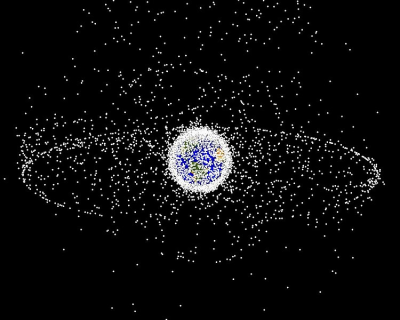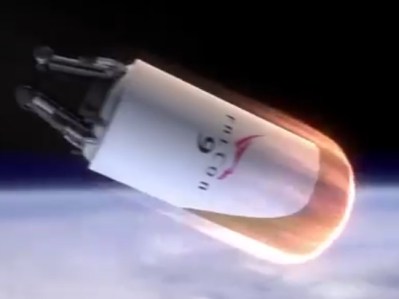In the early days of spaceflight, when only the governments of the United States and the Soviet Union had the ability to put an object into orbit, even the most fanciful of futurists would have had a hard time believing that commercial entities would one day be launching sixty satellites at a time. What once seemed like an infinite expanse above our heads is now starting to look quite a bit smaller, and it’s only going to get more crowded as time goes on. SpaceX is gearing up to launch nearly 12,000 individual satellites for their Starlink network by the mid-2020s, and that’s just one of the “mega constellations” currently in the works.

It might seem like overcrowding of Earth orbit is a concern for the distant future, but one needs only look at recent events to see the first hints of trouble. On September 2nd, the European Space Agency announced that one of its research spacecraft had to perform an evasive maneuver due to a higher than acceptable risk of colliding with one of the first-generation Starlink satellites. Just two weeks later, Bigelow Aerospace were informed by the United States Air Force that there was a 1 in 20 chance that a defunct Russian Cosmos 1300 satellite would strike their Genesis II space station prototype.
A collision between two satellites in orbit is almost certain to be catastrophic, ending with both spacecraft either completely destroyed or severely damaged. But in the worst case, the relative velocity between the vehicles can be so great that the impact generates thousands of individual fragments. The resulting cloud of shrapnel can circle the Earth for years or even decades, threatening to tear apart any spacecraft unlucky enough to pass by.
Fortunately avoiding these collisions shouldn’t be difficult, assuming everyone can get on the same page before it’s too late. The recently formed Space Safety Coalition (SSC) is made up of more than twenty aerospace companies that realize the importance of taking proactive steps to ensure humanity retains the unfettered access to outer space by establishing some common “Rules of the Road” for future spacecraft.
No More Secrets
The first directive suggested by the SSC in their document “Best Practices for the Sustainability of Space
Operations” is simultaneously the easiest and hardest to accomplish: establishing an open dialog between spacecraft owners and operators about what their respective craft are actually capable of. The aerospace industry is notoriously secretive, but the SSC argues that when it comes to safety, companies are going to have to divulge more about their hardware than they might traditionally be comfortable with.
According to the document, it’s critical that all operators are made aware of each craft’s maneuvering capabilities and intended “Flight Plan” should evasive action be required. This will allow rapidly determining which vehicle has the right-of-way in the event of a close pass. Just as smaller boats are expected to steer clear of larger and less maneuverable ships, the more agile spacecraft should logically be the one to initiate evasive maneuvers if all other factors are considered equal.
Perhaps predicting pushback from aerospace firms that are reluctant to detail the capabilities of their proprietary hardware and software, the SSC clarifies that the exchange of this information must be done in good faith and performed in such a way that it respects the intellectual property rights of all parties. In other words, don’t expect this information to be listed on Wikipedia anytime soon; while it’s important for spacefaring agencies and operators to know what each other’s craft are capable of, it’s not necessarily something the public needs to be privy to.
Voting With Your Wallet
The second directive is aimed at those purchasing launch services from commercial providers, and states that customers should stipulate in their contract that the booster which carries their spacecraft to orbit must make every effort to responsibly dispose of itself after successful completion of the mission. In other words, once the upper stage of the rocket has deposited your satellite into the intended orbit, it then must adjust its own course to either burn up in the atmosphere or continue on to deep space.

Specifically, the SSC says that launch vehicles delivering spacecraft to low Earth orbit should demonstrate at least a 90% success rate for deorbiting themselves post-mission. In the case of spacecraft heading towards the far higher geosynchronous orbits, then the launch vehicle should be able to propel itself into a deep space orbit that will ensure it doesn’t return for a minimum of 100 years.
By asking operators to take post-mission disposal of launch vehicles into account when booking passage for their spacecraft, the SSC is looking to effectively incentivize the development of more robust boosters. If customers won’t use your rocket because it can’t safely deorbit itself after payload separation, you’ll suddenly have a very compelling reason to research and implement this capability. Taking that idea a step farther, it might even spur the development of reusable upper stages, a concept SpaceX has been flirting with for years.
Safety by Design
The rest of the document, indeed the bulk of it, has to do with best practices for those designing and manufacturing spacecraft. These recommendations include both active and passive steps that can be taken to give a spacecraft the best chance of survival in an increasingly crowded airspace, but also ways to make sure the vehicle doesn’t inadvertently become a piece of space trash itself.
It seems like it should go without saying, but one of the first recommendations is that spacecraft be thoroughly tested on the ground to prevent a Dead-On-Arrival (DOA) condition. But the reality is that testing can be expensive and time-consuming, and the new breed of low-cost miniature satellites are often designed and assembled on an extremely tight budget. You don’t have to look long to find examples of CubeSats that failed as soon as they were released from their carrier rockets.
The SSC also recommends that satellites be deployed into a lower, less trafficked, orbit until a self-diagnostic test confirms they are fully functional. This means it will take more time and propellant to get a satellite into its intended orbit, but the advantage is that if the craft ends up DOA, it’s less likely to be a hazard to navigation. In a low orbit, even a non-functional spacecraft will dip back into the atmosphere and burn up in a relatively short period of time. SpaceX utilized this approach for the first Starlink launch, and in the end found that three of the sixty satellites never passed their self-check and failed to move on from their initial “parking” orbit.
Finally, the SSC agrees with the European Space Agency that future satellites should utilize “Design for Demise” or D4D. These are design principles which ensure that even a non-functional satellite will deorbit itself and completely burn up in the atmosphere. Techniques include spacecraft shapes and orientations that maximize atmospheric drag, and the use of thermal reactive adhesives which will release as the vehicle heats up during reentry.
Actions Speak Louder than Words
While the Space Safety Coalition’s list of best practices for designing and operating spacecraft in Earth orbit are reasonable and in many cases logical, the group has no authority to actually enforce them. As such, any company that decides to follow these rules does so of their own volition. Smallsat launch providers Virgin Orbit and Rocket Lab have already decided to endorse the document, as have some companies which operate fleets of satellites, such as SES and Iridium.
 But while it’s encouraging to see early support from industry players, there are a number of very high profile names currently missing from the list of endorsees. First and foremost is SpaceX, which is not only the world’s premiere commercial launch services provider, but in the future will operate the largest fleet of individual spacecraft ever assembled. Also absent are major aerospace companies such as Boeing, Northrop Grumman, and Lockheed Martin, firms that are responsible for designing and building a vast array of civilian and military satellites.
But while it’s encouraging to see early support from industry players, there are a number of very high profile names currently missing from the list of endorsees. First and foremost is SpaceX, which is not only the world’s premiere commercial launch services provider, but in the future will operate the largest fleet of individual spacecraft ever assembled. Also absent are major aerospace companies such as Boeing, Northrop Grumman, and Lockheed Martin, firms that are responsible for designing and building a vast array of civilian and military satellites.
If the industry has any hope of getting a handle on critical elements of close-quarters spaceflight like collision avoidance and spacecraft disposal, it’s going to take more than a handful of companies signing their names to a non-binding agreement. Larger companies will need to be persuaded to align themselves with the ideals of the Space Safety Coalition soon, as the ever increasing pace of orbital launches means that we might not have a lot of time left before things reach a tipping point.
No comments:
Post a Comment